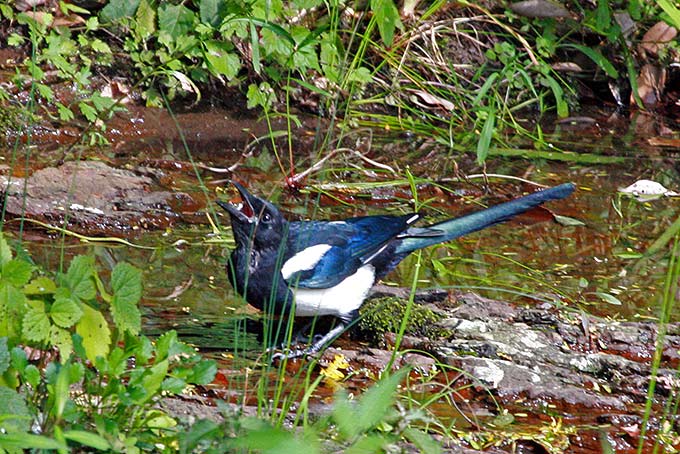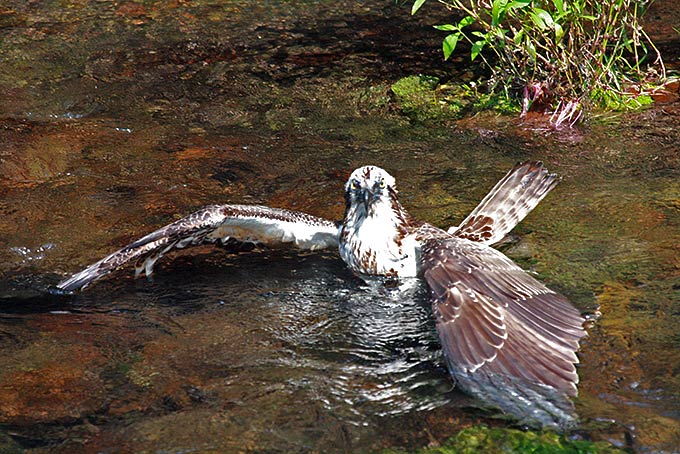 | E-mail to Birds Korea |
 | KWBS |
in the Region
 | The Oriental Bird Club |
 | BirdLife International (Asia) |
September
Temperatures begin to cool, especially towards the end of the month, with maxima often falling from 28°C to 20°C. Sunny, dry weather predominates, though often punctuated by occasional heavy rain and very strong winds associated with typhoons.
September sees migration pick up considerably, with a build-up of ducks including the first returning flocks of Baikal Teal by mid-month. Seabirds still provide much interest (with small but increasing numbers of jaegers and dark shearwaters possible), while shorebirds like Nordmann’s Greenshank and a very few Spoon-billed Sandpiper can be found at prime sites, such as the Geum and Nakdong Estuaries, with other Yellow Sea “specials” also at Hwaseong (Namyang Bay) and Song Do (Incheon). Whiskered and White-winged Black Terns, although scarce in South Korea, become rather more widespread with small flocks of the latter at Seosan and in Gunsan, along with an increasing number of Mongolian Gull. Raptor migration includes large concentrations of Chinese Sparrowhawk making their way towards Japan (where over 50 000 have been recorded in one day on an island in the Korean Straits only 40 km south of Busan!), along with smaller flocks of Grey-faced and Crested Honey Buzzards, and very small numbers of Pied Harrier and Amur Falcon especially through the west and northwest. Passerines become rather more numerous and perse, with Thick-billed Warbler and Brown Shrike early in the month, good numbers of Eastern Yellow Wagtail , Pechora Pipit, and the three species of "grey-brown flycatchers" by mid-month (some Dark-sided and Brown still, with a peak in Grey-streaked). Towards the very end of September, Olive-backed and Buff-bellied Pipit migration starts in earnest, and the first small flocks of buntings also arrive, with most numerous being Chestnut and Black-faced.
September holds the chance of national rarities like Rose-coloured Starling, Ashy Drongo, Tree Pipit, and South Polar Skua. Firsts for Korea in recent years have included Steppe Grey Shrike in 2004, Eurasian Dotterel in 2005, Willow Warbler in 2006, and Wood Warbler and Buff-breasted Sandpiper in 2007.
(The following records are a compilation of our own sightings and records sent in by other observers. As well as being posted on the Birds Korea website(s), selected records are also forwarded to other Korean-language birding websites; records of threatened species are arranged and forwarded to Birdlife International and national authorities when appropriate; flag images and records are passed to bodies responsible for their coordination throughout the flyway; and all records sent to us are used to compile annual reports and to support the evolving understanding of the status of many of Korea’s birds.)
Gageo Island, September 30
With rain, occasionally heavy, through early into mid-morning, a few more birds in, with 51 species logged on the 1-Gu circuit. Main highlight included the (undisputed) Red-backed Shrike still, with another juvenile Red-backed Shrike or perhaps a hybrid (Brown x Red-backed?), a juvenile Brown and two Bull-headed Shrikes (seven logged during the day) all in the quarry, presumably the same Red-headed Bunting relocated (this time by the garbage dump), with a Blyth’s Pipit and a juvenile von Shrenck’s Bittern new in. Personal firsts for the autumn included Buff-bellied Pipit and a lugens White Wagtail, while a Pomarine Skua heading southwest over the sea might be the first record of this species from the island itself? Low point of the day was finding a freshly-dead Siberian Thrush on the road, hit by a car.
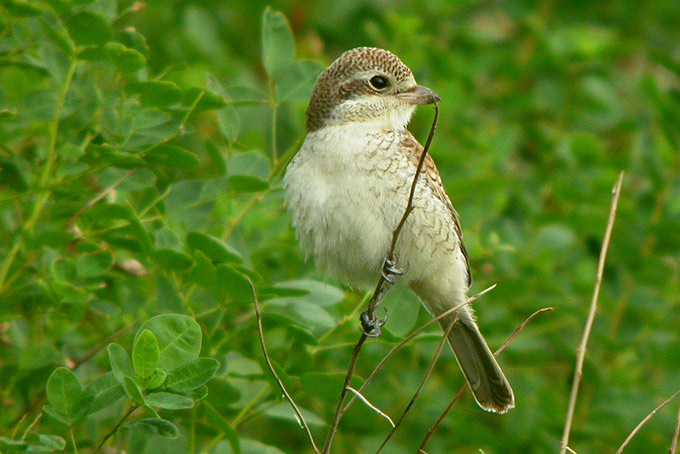


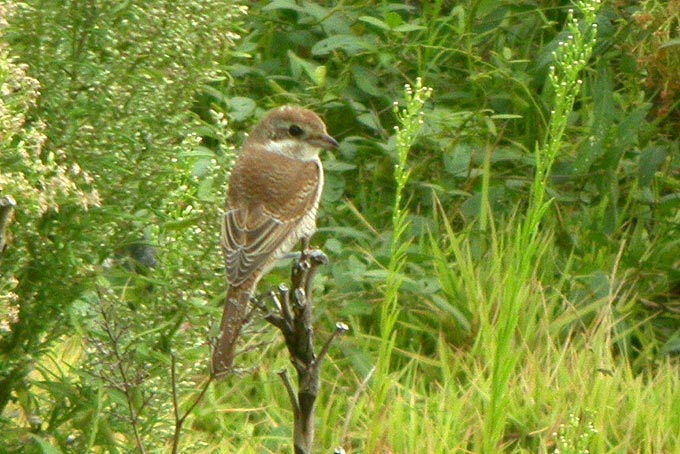

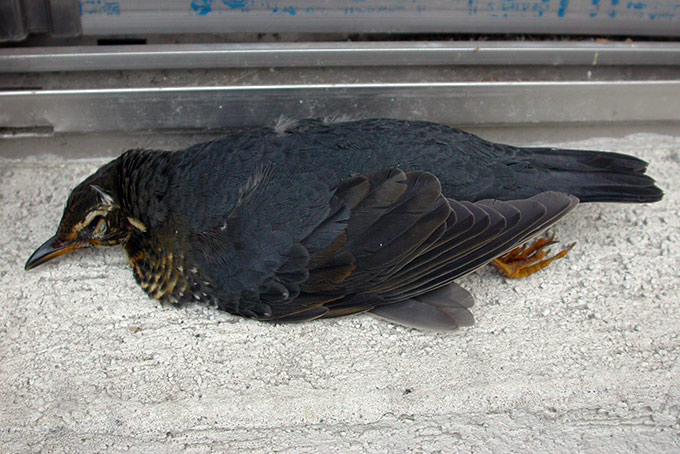

Gageo Island, September 29
In dry conditions with a moderate northeasterly, many birds seem to have moved on, perhaps including yesterday’s Red-headed Bunting. The 1-Gu morning circuit produced only 39 species, with none numerous and e.g. only single Arctic, Yellow-browed, Oriental Reed and Middendorff’s Grasshopper Warblers, and a “high” count of just 10 Little Bunting. Species of most note included a juvenile Styan’s Grasshopper Warbler (finally seen well after several days of ’possible’ glimpses), five Black-tailed Gull (the first of the autumn on the island), five Far Eastern Cisticola and outstanding highlight, a juvenile Red-backed Shrike. Although identification of juvenile shrikes is often complicated (due to huge individual variation and potential confusion with hybrids and/or the still unrecorded Isabelline Shrike), this individual appeared very pale (largely white) on the underparts, had greyish tones to the crown at certain angles, was very heavily marked above (beyond the range of juvenile Brown or Isabelline), showed a clearly square-ended tail, with clear and strong black subterminal marks (just visible in one or two images), and a fairly long primary projection: all very good Red-backed features. There are at least two previous confirmed records of Red-backed Shrike, both in September, one from Hong Island (http://www.birdskorea.org/Birds/.../BK-RR-Red-backed-Shrike-2004-09.shtml) and one from Heuksan Island, both found/co-found (and even banded!) by Park Jong-Gil and the National Parks Migratory Bird Research Centre, on September 16th, 2004, and between September 14th-16th, 2005. In addition, there have been probably another six or more records of juvenile shrikes that were either suspected as Red-backed Shrike, or were shown on close examination to have some hybrid features.


Gageo Island, September 28
After heavy rain for much of the 27th, the day dawned brighter, with strong northeasterly winds. In total, 56 species logged for the day in 1-Gu and 2-Gu, with outstanding highlight a Red-headed Bunting, that was first seen late yesterday afternoon in dark and damp conditions (when two such buntings were suspected). Females and immatures of the Red-headed and Black-headed species pair are notoriously difficult, sometimes impossible, to identify with confidence. However, today's individual was 'small' (almost suggesting Common Rosefinch), small-billed, poorly streaked on the crown, brownish overall, lacked any grey tones on the head (rather showing some warmth there) or on the mantle, and also showed some olivey-greenish tones/tinges to the rump. Although "very well-marked on the mantle" the initial identification by NM as Red-headed Bunting is also supported by Paul Leader (who kindly reviewed three images, and is very experienced in separating extralimital individuals of these two species in Hong Kong). There are still fewer than ten confirmed records nationwide of Red-headed Bunting, though there are several records of birds (better) left unidentified. Other species of note today included a single Northern House Martin with three Asian House Martin, at least seven Light-vented Bulbul, a Chinese Pond Heron flying in in the evening, and at least 20 Crested Honey Buzzard.
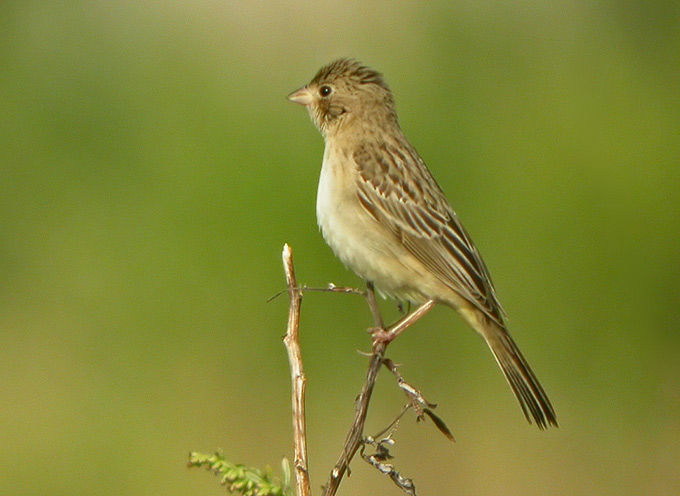
Heuksan-do, September 24-26
The ferry from Mokpo (with limited outside access) was virtually birdless. On Heuksan in the evening and calm, warm, overcast weather, highlights were a juvenile Baillon’s Crake (with a second, apparently adult bird seen briefly in flight), several Common Snipe and one probable Swinhoe’s Snipe, a Long-tailed Shrike (one of a long-staying pair, according to Mr. Park Jong-gil of the National Parks Service), a single Pechora Pipit, a Far-Eastern Cisticola Warbler, an Oriental Reed Warbler, flocks (mostly heard) of Japanese Whiteyes and Pale Thrushes, and a fly-over flock of 10 Chinese Grosbeaks.
The 25th started overcast and changed to steady rain by 9:30 am; birds in the morning included 12 Honey Buzzards high up and from the north, a few (heard) Red-throated Pipits, a (seemingly Japanese) Bush Warbler, a Eurasian Curlew on the beach and a Common Redshank on the muddy stream, the Long-tailed Shrike again, and the brief fly-by of a juvenile Schrenck’s Bittern.
The late afternoon (still raining) added a few calling Yellow-browed Warblers.
The morning of the 26th before the boat was clear; perhaps some increase in calling pipits (Red-throated and probably an Olive-backed) and several Grey Wagtails; at the (“1st”) wetland area, the Long-tailed Shrike, singing vociferously from an exposed perch, was answered briefly by a more distant and unseen bird; the juvenile Baillon’s Crake made a semi-visible appearance, and a few more Honey Buzzards drifted over. The return boat (no outside access) was better for Streaked Shearwaters than the 24th’s: about 30 tallied.
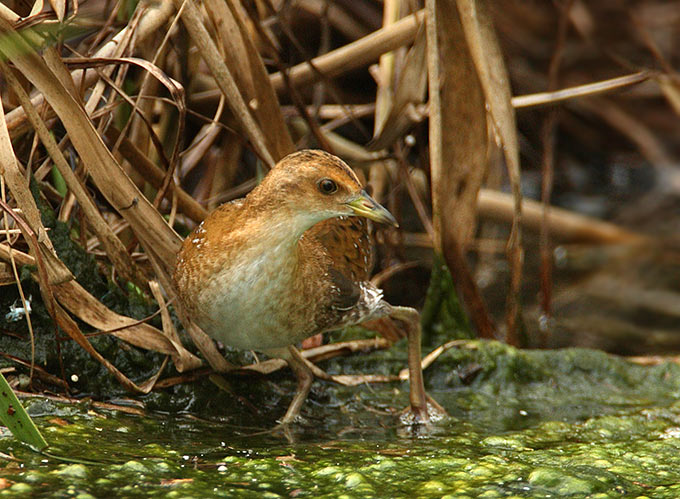
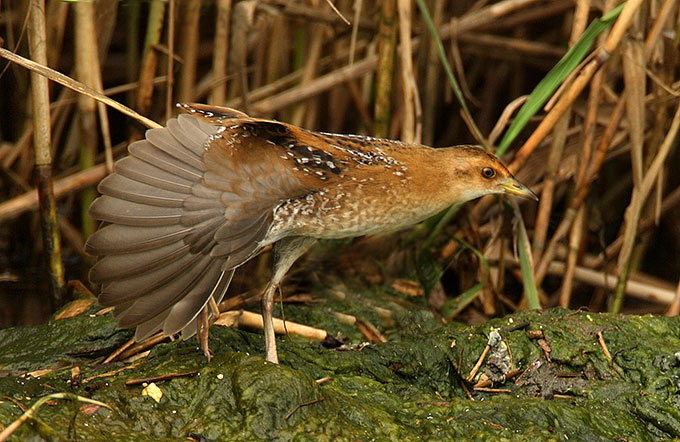
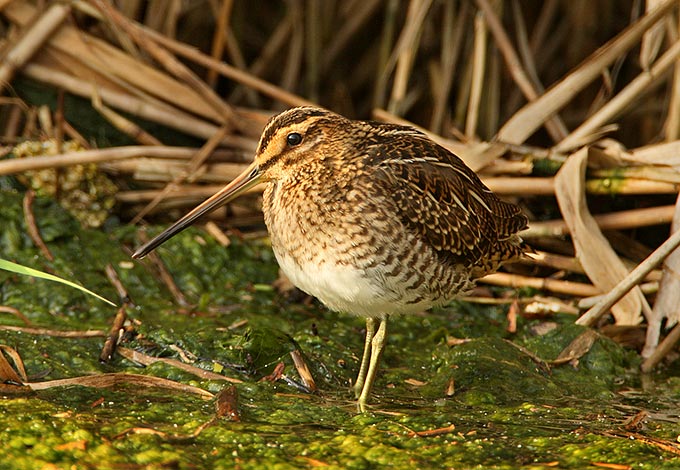


Mokpo Namhang Urban Wetland, September 26
The morning was shared with Dr. Kim Seok-Yee from the Mokpo Natural History Museum holding a bird watching class for 3rd grade students of the Jangheung Girls Middle School (about 50km east of Mokpo). A short inspection of the reed bed area before the class revealed a Chinese Pond Heron flying off together with a Black-crowned Night Heron heading into the pond in the middle of the reed bed. Species seen were like the days before. In addition during the class several Red-necked Stint and 1 Bar-tailed Godwit were observed feeding. A big challenge for the students were the task to find the Black-crowned Night Heron in the reed.


Gageo Island, September 26
A morning circuit of 1-Gu in dry though still cloudy weather after yesterday’s rain produced several interesting birds, with a Grey-headed Lapwing flying round the harbor (perhaps flushed from somewhere more suitable) the obvious highlight, and quite likely a first for Gageo. Other species of note included a Temminck’s Stint (sharing the “mossy slab” with a Red-necked Stint and the juvenile Sanderling still), two Siberian Thrush, a single Grey-streaked Flycatcher (extremely scarce this autumn compared to previous years), three Chinese Grosbeak and a slight increase in pipits and wagtails, with e.g. now eight Red-throated and eight Richard’s Pipits, ten or more Olive-backed and four Pechoras.



Gageo Island, September 25
The morning circuit of 1-Gu started dry and overcast at 6AM, but soon became wetter, with rain becoming increasingly heavy and continuing till well after nightfall. A few birds seemed to come in with the weather, including a Taiga Flycatcher and a Far Eastern Cisticola and a decent-sized flock of hirundines, made up mostly of Barn (150) and Red-rumped (100) Swallows.
Mokpo Ferry-Gageo Island, September 24
Extremely bird-poor from the ferry, with a total of only seven Streaked Shearwater, and highlights limited to three Grey Wagtail flying north over the sea, and c1400 Black-tailed Gull in and around Heuksan - easily the highest count since the spring. On Gageo too rather quiet, with three Black Kite and the concrete boat ramp (wistfully nicknamed “the mossy slab’” back in the spring by a well-known Medieval English Lit. professor) holding two Grey and one Mongolian Plover, a Red-necked Stint and a Sanderling - the latter perhaps a not-unexpected addition to the Gageo list?
Mokpo Namhang Urban Wetland, September 23
The most dominant species in numbers and appearance these days are Egrets and Herons with 200+ Eastern Great Egret, 50+ Grey Heron and about 30 Little Egret. Also back like last year Black-crowned Night Heron hiding in the reed during the day. This day 9 individuals including 2 juvenile were seen.
The number of shorebirds is quite small now, only about 20 Common Greenshank, less than 10 Common Sandpiper and 3 Green Sandpiper were seen. Highlight of this day was the appearance of a second Common Snipe and 4 juvenile Common Redshank.
The first winter visitors have arrived with 15 Common Teal and a single Mallard. Also worth to notice one Striated Heron sitting in a pine tree, one Common Kingfisher and a Common Kestrel. In the adjacent trees the usual Brown-eared Bulbul, Eurasian Magpie, Oriental Turtle Dove and Tree Sparrow in small numbers.

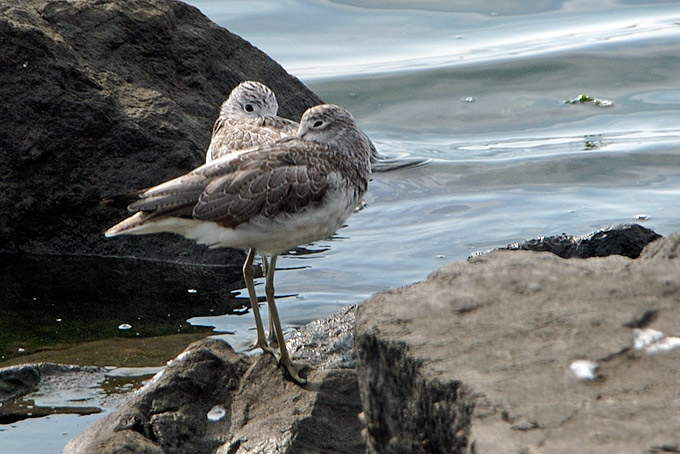


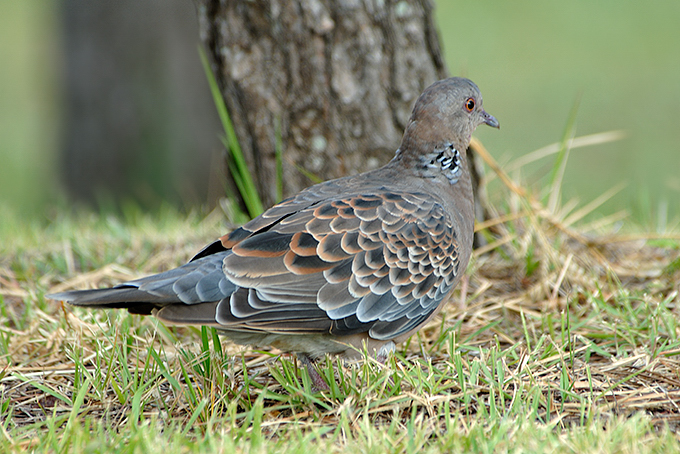
Socheong-Incheon, September 22
Warm, calm and Yellow Dust at dawn, with a slight east wind and rise in visibility through the morning. Again, birds were fairly hard to find with best a juvenile Northern Hawk- Cuckoo landing and then concealing itself in 'the bush' at North Point, and the runner-up (for NM at least) the personal first Brambling of the autumn. These were followed by a small passage of raptors, mostly Crested Honey Buzzard, but including single Black Kite and Pied Harrier and the personal first Eurasian Sparrowhawk (2) and Northern Goshawk (1) of the autumn. From the ferry back to Incheon, 10 Pomarine Skua and an obvious increase in Black-tailed Gull - though no petrels.

Incheon-Socheong, September 21
Chasing the rain that fell in the early hours, the ferry journey was largely uneventful save for 3 or 4 Swinhoe's Storm Petrel and a single large alcid, that was seen taking off at medium range, away from the boat. While the bill was not well seen (heavy but not massive was the impression), based on its clean black and white plumage (including "black head" and white secondary trail) identification can be made tentatively as Brunnich's Murre, though it is perhaps impossible to rule out Common Murre (or even an extralimital Razorbill!). We know of no previous records of any alcid larger than Rhinoceros Auklet from the Korean Yellow Sea, and the date is believed exceptional early for any murre in Korean waters. On Socheong itself, rather quieter than expected, with best a single Black Paradise Flycatcher at the lighthouse, and a Von Shrenck's Bittern in the valley. While there were very few raptors, according to Mishima Takanobu and Igari Atsushi, together with Kim Sung-Hyun they counted 1,100 Crested Honey Buzzard over Socheong on 20th, with 1000 of these moving east (presumably after failing to cross the Yellow Sea due to inclement weather between Korea and China), and two Pied Harrier and an Amur Falcon on the morning of the 21st.
Hwaum Temple (AM) and Seosan Lake A (PM), September 20
A quick trip down to the temple complex was rewarded with good views of (however, only) seven Hill Pigeon, and excellent views of one or two White-backed Woodpecker, with Long-billed Plover and Japanese Wagtail still present on a nearby river. At Seosan, unsurprisingly considering the recent months of "green development" around the nation, road-widening and bridge enlargement apparently along both sides of the reclamation lake, and rather few birds. Highlights included a highly unseasonal Little Whimbrel, c15 Baikal Teal, 5-6 Eastern Marsh Harrier (a personal day high count), two early Black-browed Reed Warbler, and in the evening flocks of 77 Far Eastern Oystercatcher and of 25 Pechora Pipit.
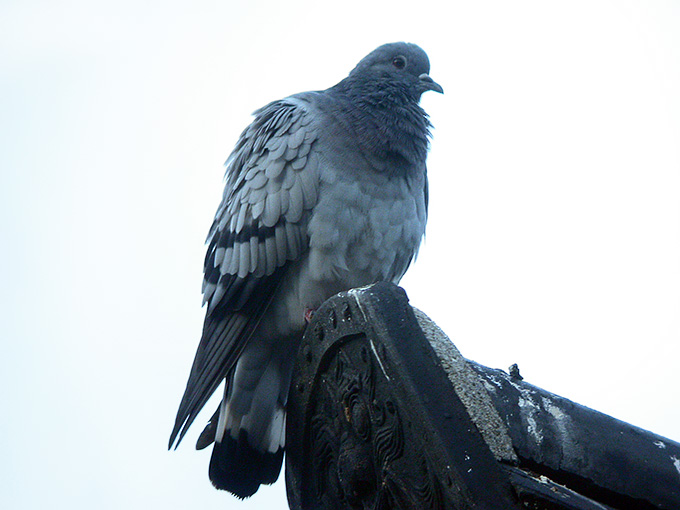

Hwaseong/Uiwang, September 19
At the reclaimed coastal ricefields of Hwaseong, a spectacular juvenile Pied Harrier sailing over reeds was then watched for c.15 minutes at close range, devouring a frog - when it appeared quite unperturbed by the close approach.
Some 300+ Barn Swallow were massing above the nicely overgrown freshwater channels, and a Richard's Pipit scurried along the road. A brief look in at Uiwang revealed a flock of c.15 Eastern Yellow Wagtail.
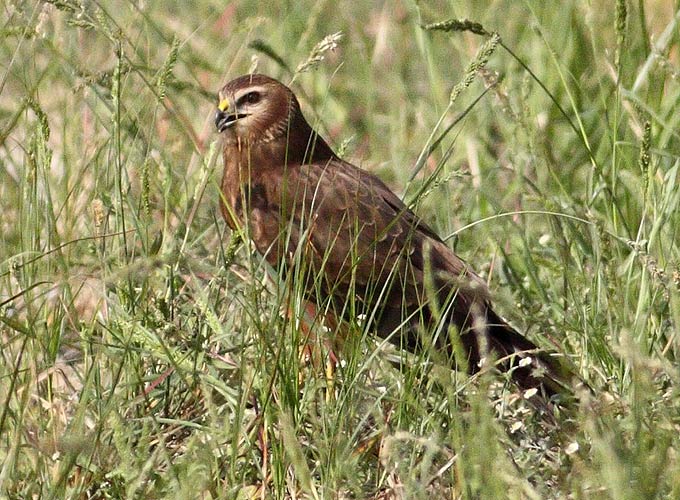
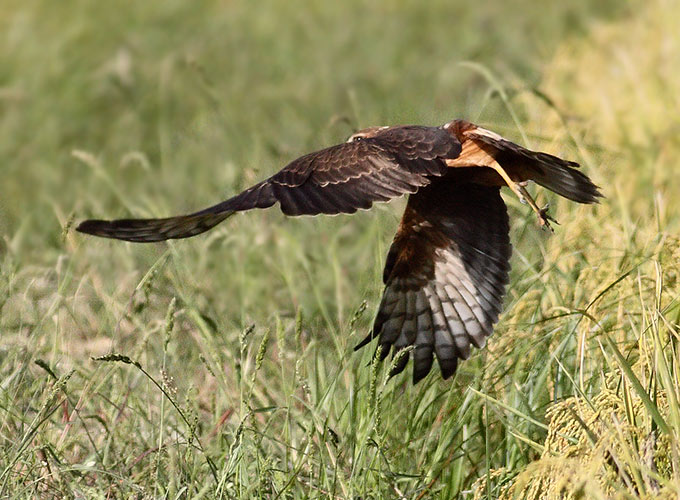

Cheju, September 19
The boat to Mara-do was cancelled due to high winds; however, the harbor did harbor 4 Pacific Reef Herons; we then met up with Cheju bird authority KYH, who drove us up the west coast, stopping at a number of hidden wetland sites, back toward Cheju City. We found small numbers of the following shorebirds: Dunlin (8), Red-necked Stint (c.30), Long-toed Stint (1), Common Snipe (1) Broad-billed Sandpiper (1), Grey-tailed Tattler (4), Ruddy Turnstone (3), Common Sandpiper (5), Sanderling (25) and Whimbrel (2). We also tallied an Osprey, 2 more Pacific Reef Herons, and 3 Richard’s Pipits along the way.
The late-afternoon return ferry (over rougher seas this time) allowed about two hours of daylight. Until sunset the number of Streaked Shearwaters was similar to the previous day’s count, but as light faded several hundred filed past the prow on their way to island roosts. The count of Red-necked Phalaropes was slightly higher: about 90-100.






Gwacheon AM Yubu Island PM, September 19
A site now known for thrushes held a few secretive Pale and Grey-backed Thrushes, probably two Siberian Thrush and a single Blue-and-White Flycatcher, while a site now known for Spoon-billed Sandpiper (!) held probably seven of this Critically Endangered species, 15 Nordmann’s Greenshank, 6 Chinese Egret and decent numbers of other shorebirds, with most exceptional being an estimated 1300 Broad-billed Sandpiper.

Mokpo-Cheju Ferry, September 18
The Queen Mary, largest of the Mokpo-Cheju ferries, with 3 levels of viewing deck, sailed through calm seas and clear, bright weather. Once past the southern archipelago, Streaked Shearwaters began to show, mostly few and far-between but with a few larger groups: about 180 for the trip. Other birds of note were about 70 Red-necked Phalaropes, 5 Common Terns and (just off Cheju) one Flesh-footed Shearwater.
Once on the island, I made my way to Hado-ri on the northeast coast, where a small lagoon held 20 (mostly juvenile) Red-necked Stints, 30 Dunlin, 3 Common Redshanks, 8 Common Greenshanks, 5 Wood Sandpipers, 3 Common Sandpipers and a family of Moorhens.
Socheong Island, September 18
Despite some early morning cloud (and a near moonless night) rather few migrants either on the ground or on the move. Species of most note in the morning before the ferry included 2 Pacific Golden Plover west, single juvenile Blyth’s Pipit and Middendorff’s Grasshopper Warbler, at least 5 Bull-headed Shrike, a similar number of Japanese Sparrowhawk, the personal first Rufous-tailed Robin of the spring, and yet another couple of cuckoo sp - including one presumed juvenile Common Cuckoo balancing acrobatically in a strengthening wind.
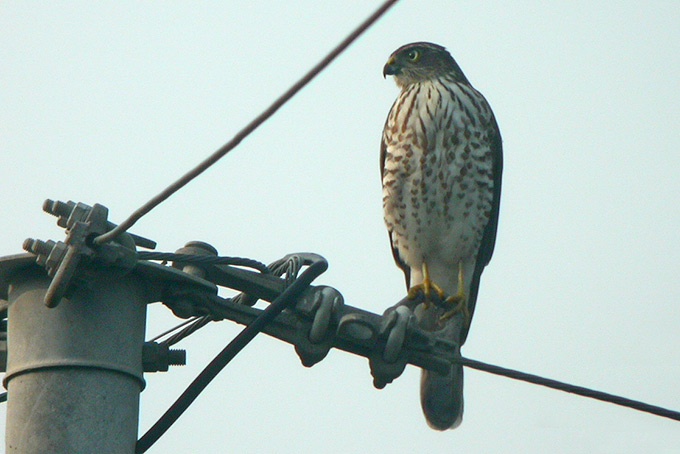

Socheong Island, September 17
Hazy conditions, with visibility generally less than 20km, but prolonged watching at North Point produced 66 species, with best including 30 Crested Honey Buzzard, three Eastern Marsh and two Pied Harriers and the personal first Amur Falcon of the autumn.
Socheong Island, September 16
57 species logged during the day, with most numerous on the land including Yellow-browed Warbler (65) and Common Rosefinch (c20 in total), with 4400 Streaked Shearwater counted from North Point at dusk (where there were also 190 Finless Porpoise). Of further note was an unidentified cuckoo species. Although apparently a juvenile (based on e.g. the pale upperpart fringing and pale nape patch) its eyes were clearly pale. Help with id of this extremely tricky group always warmly welcomed!).



Socheong Island, September 15
Species of note included two Far Eastern Cisticola and two Varied Tit - both species appearing rather richly colored (subspecies?).



Mokpo Namhang Urban Wetland, September 15
On a very sunny morning the number of birds not much different to September 13 except from the flock of Red-necked Stint only 4 remained on the site. Also seen were 4 Grey Plover and 2 Great Knot from very close range.
The negative news for the site is the first fill-in of the wall enclosed lagoon beside the natural tidal flat - a next step to the destruction of the site.
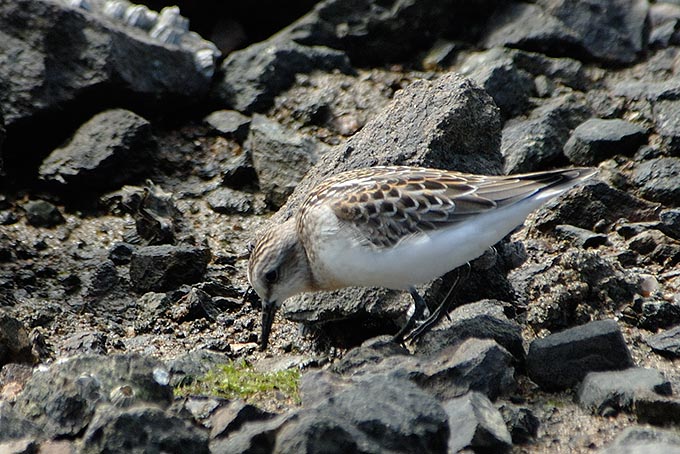


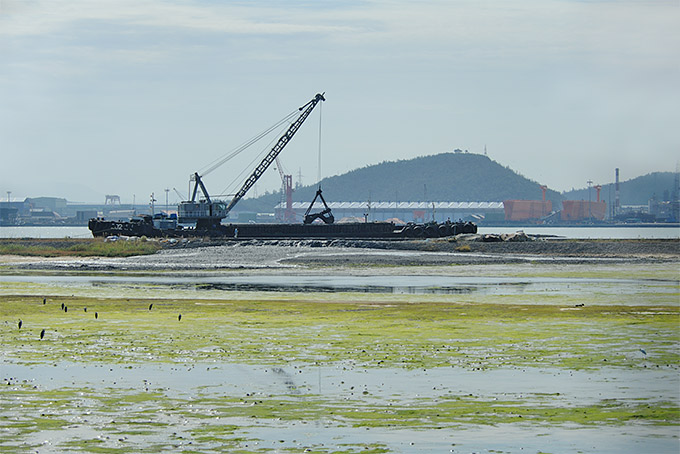
Seogwipo, Jeju island, September 15
Some interesting bird activity in a Seogwipo park, on an overcast day. Several Arctic Warblers flitted through trees, loosely associating with a flock of Japanese White-eye. A decidedly scruffy Brown-eared Bulbul showed an odd silhouette, while a conspicuously quiet female Black-naped Oriole lurked in nearby tree tops. Two Oriental Cuckoos continue to gorge themselves on caterpillars in riverside trees, and a scolding Bull-headed Shrike dueled with an equally agitated Grey Wagtail for several minutes.


Socheong Island, September 14
A more interesting day, with most noteworthy being four species of shrike (with the personal first migrant “Bull-heads” (two) of the autumn, Brown (15+), Tiger (1) and Chinese Grey (1), as well as the personal first Eurasian Woodcock of the autumn and a presumed Yellow Bunting (moving NW with several Yellow-browed Buntings).
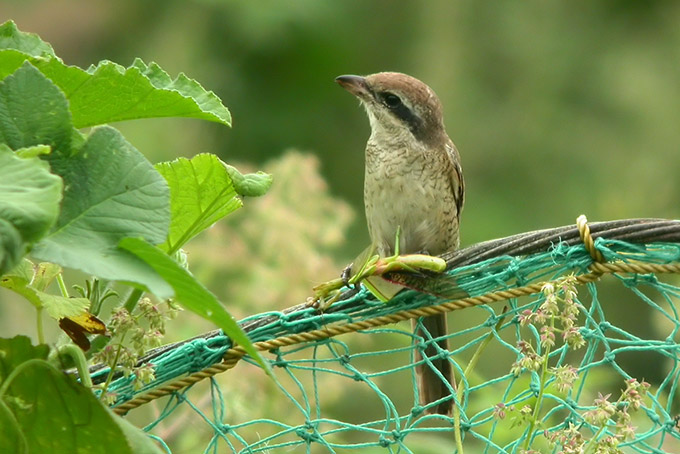

Incheon-Socheong Ferry & Socheong, September 13
Rather disappointing from the ferry with only 130 Common Tern, two Swhinhoe’s Petrel and the highlight the personal first Taimyensis gull of the autumn … On Socheong itself in rather warm (25C) sunshine only c37 species in the east, with species of most note including 32 Chestnut-flanked White-eye, a presumed juvenile Lesser Cuckoo (based on structure: comments welcome!), at least 15 Yellow-browed Bunting and half-a dozen Common Rosefinch, along with single Flesh-footed Shearwater and adult Pomarine Skua seen close to shore from the SE pagoda.


Nakdong estuary, September 13
4 Spoon-billed Sandpiper and 5 Common Ringed Plover were seen and photographed.
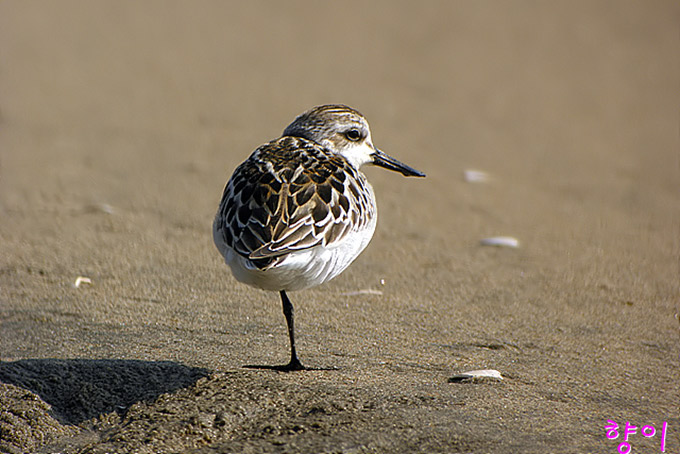

Gwacheon, September 13
An afternoon visit to the Wildflower Park, a traditional gathering site for thrushes and their appetite for berries. About a dozen Grey-backed Thrushes and 3 Siberian Thrushes (an adult male, an adult female, and a first year male) moved restlessly in the leaves; these were joined by at least 5 Blue and White Flycatchers, 1 or more Mugimaki Flycatchers, Varied (heard only), Great, and Marsh Tits, a few Eurasian Jays, a distant (heard) Common Cuckoo, and a Grey-headed Woodpecker. Flyover raptors included an Eurasian Hobby and a Chinese Sparrowhawk.




Mokpo Namhang Urban Wetland, September 13
The early morning visit to the site in already sunny weather showed the natural tidal area almost completely filled with water which left not much roosting area for the birds. While only 5 Common Sandpiper, 7 Common Greenshank and 2 Terek Sanpiper stayed in the rocky side walls 7 Grey Heron, 7 Little Egret and 23 Eastern Great Egret were wading in the shallow water. The adjacent wall enclosed lagoon had almost no water so most of the birds stayed here. Highest numbers were 107 Common Greenshank and 99 Black-tailed Gull, 35 Red-necked Stint, 34 Grey Heron, 32 Eastern Great Egret and 23 Common Sandpiper. In small numbers (2-7) also seen Grey Plover, Whimbrel, Ruddy Turnstone, White and Grey Wagtail, Little Egret. Beside the lagoon a flock of 100+ Treesparrow moved from tree to tree. In addition 4 Oriantal Turtle Dove, 3 Eurasian Magpie and 2 Brown-eared Bulbul were seen. The second wall enclosed lagoon hold another 30 Eastern Great Egret and 10 Little Egret. Of notice in the reed-bed area were 3 Eastern Spot-billed Duck, the (this summer always present) Green Sandpiper, 3 Common Sandpiper and a single Common Snipe, seen first time on September 10th.


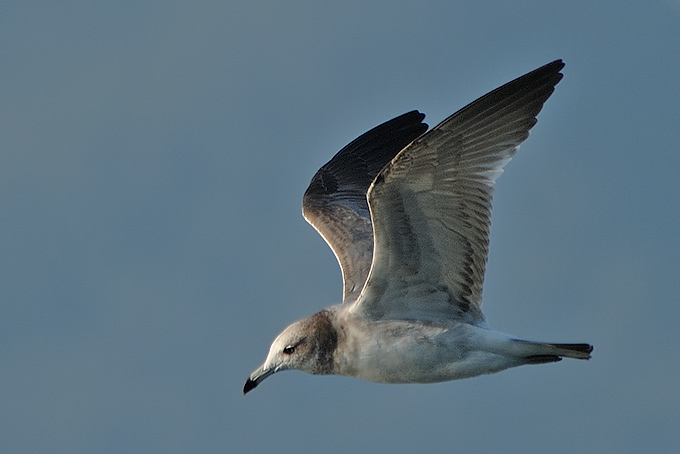



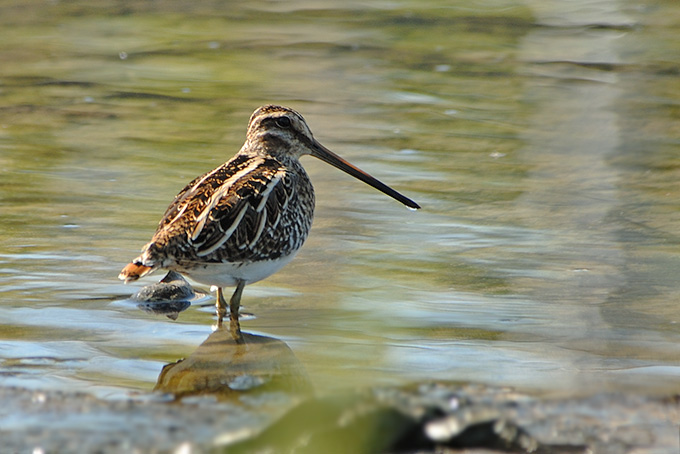
Hwaseong & Mehang-ri/ Namyang Bay, September 6
In ricefields on reclaimed land at Hwaseong, Common Snipe, Wood, Marsh and Green Sandpiper proved most plentiful, with handfuls of Sharp-tailed Sandpiper & 1 Long-toed Stint. In reeds, 1 Oriental Reed and 1 Arctic Warbler. Amongst nearby farmland, a Northern Hobby and Azure-winged Magpies, also several Eastern Yellow Wagtail, a Common Kingfisher and Moorhen family.
High tide at Mehang-ri gave a distant view (RN only) of the Asiatic Dowitcher photographed here yesterday, and 1 Nordmann's Greenshank (TE only). In addition, low numbers of the usual suspects, including c. 50 Far Eastern & c. 15 Eurasian Curlew, 30 Whimbrel,10+ Grey-tailed Tattler, 10+ Mongolian Plover, 5 Broad-billed Sandpiper, 3 Red-necked Stint, 100 Dunlin, 500 Great Knot, several Red Knot, Common Greenshank, 60 Grey Plover, 10+ Kentish Plover, 30- 40 Bar-tailed Godwit, 5 Black-tailed Godwit, 20+ Ruddy Turnstone, several Terek Sandpiper, and 1 Chinese Egret.

Aphae island, September 6
During the visit of the two huge tidal flats on the island on low tide showed only some Egrets and Herons which were also seen everywhere along all the inland's shores and in the rice fields.
Later the day on high tide the number of birds found was rather depressing. At the northern end of the southern tidal flat only 27 Common Greenshank, 25 Terek Sandpiper, 12 Grey Plover and c. 200 Kentish Plover accompanied by c. 30 Great Egret where found. Most noticeble there was a single Striated Heron on an electric wire later chased away by a small number of Barn Swallows.
On the northern tidal flat the numbers were not big as well. 24 Grey Plover, 13 Common Greenshank, one Black-tailed Godwit, 2 Terek Sandpiper and 51 Whimbrel along with 21 Great Egret, 5 Little Egret and a single Grey Heron was all to see.
Also noticed at several locations was the gathering of Barn Swallows into bigger groups - one counted with 42 at one house while smaller groups 5-7 could be seen flying around at many locations.


Songdo, September 5
At the lagoon, 47 Black Faced Spoonbill contained many juveniles: here, and moving further through vast areas of reclaimed former mudflat, revealed in total approximately 800 Black-tailed Godwit (feeding with rapid sewing-machine action), 100 Dunlin, 400 Common Greenshank, 40 Common Redshank, 1 Long-toed Stint, 30 Marsh Sandpiper, 20 Broad-billed Sandpiper (resembling miniature snipe in their breeding plumages), 10 Grey Plover,2 Eastern Oystercatcher and several each of Sharp-tailed and Common Sandpipers.
Also frequenting these bare temporararily-created moonscapes, 2 Eastern Yellow Wagtail, a White Wagtail, a Common Kingfisher, Kestrel and Peregrine. At the edges of large puddles of trapped rainwater, scattered corpses of dead birds suggest botulism may have returned.
At the very overgrown golf course, 2 Common Cuckoo,1 Asian Brown and 1 Dark-sided Flycatcher.
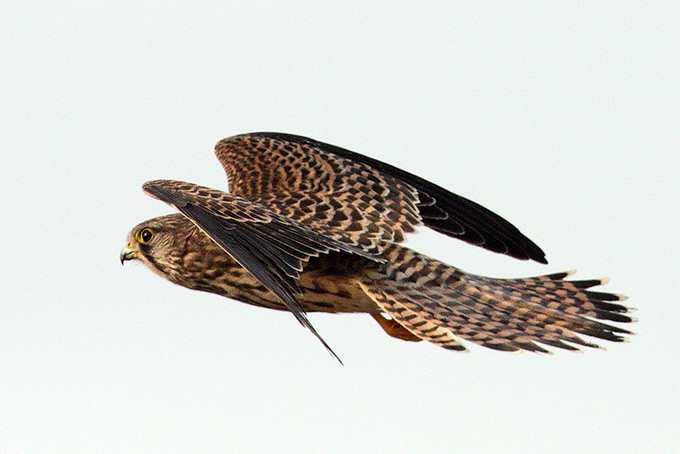

Seogwipo, Jeju island, September 5
Great sunny weather for birding in a park near downtown Seogwipo. The river was busy with regulars like Grey Wagtails, Eurasian Magpies, Spot-billed Ducks, Little and Intermediate Egrets, Common Kingfishers, Bull-headed Shrikes, Common Sandpipers, and Blue Rock Thrush. A personal first for this park was a juvenile Oriental Cuckoo, that silently fed and flew back and forth across the river. I almost fell off my rock when a Western Osprey dropped into the river 20 feet in front of me. It drank from the river, then stretched out its wings and drifted in the current, until it finally flew off a few minutes later, closely but briefly pursued by 2 agitated Grey Wagtails.
